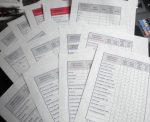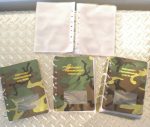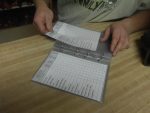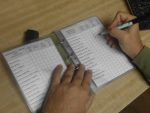Where’s your emergency checklists? The worst part about emergency situations and disasters is that they never happen when it is convenient. It’s 2 AM and you awake to find someone pounding on your door. The dam has been breached and you have maybe 30 minutes to get to high ground. What would you do? How do you know what steps to take? What items would you take with you, and how would you prioritize things?
Emergency Chaos
Maybe you live in New Orleans or one of the other Gulf States. A category 5 hurricane is bearing down on you. Do you know what supplies you need and do you know what you currently have? Do you have the necessary medications, first aid, and firearms? “Where is everything at?” you think to yourself, as you frantically search around in the darkness groping for batteries for your flashlight.
Or maybe you hear and feel a huge explosion. The ground literally shakes underneath you as a natural gas pipeline explodes down the street. Your cell phone is broken to smithereens after it fell off the kitchen counter onto the floor below. You need to reach your son and daughter, but you do not remember their cell phone numbers! Oh goodness why didn’t I write them down somewhere?
A Checklist to Organize, Coordinate, and Focus in Emergency
If you have never asked yourself questions like this before, it is definitely time for you to consider making an emergency plan for situations like this while you still have time. Having been through a couple of disasters previously, one of the things that I developed was a comprehensive Emergency Checklist to help me organize, coordinate, and focus on what needs to get done.
The Difference Between Life and Death
When things erode into total chaos, a simple Emergency Checklist can mean the difference between life and death. One of the hardest things to do when disaster strikes is to focus on what is truly important. There will be lots of distractions, lots of confused people and waiting on FEMA or government officials to show up. This help is not much of a plan at all in my opinion. You can almost bet that they will show up late, ill-prepared, ill-tempered, and completely disorganized.
Use of Checklists Improved Commercial Airline Safety
Pretty much everyone reading this has flown on a commercial airliner at least once or twice in their lifetime. While it is not everyone’s cup of tea it is for the most part a very safe way to travel. That wasn’t always the case, however. Once upon a time, commercial flight was a pretty risky affair. Lots of mishaps and crashes occurred in the late 1930’s and 1940’s. Flight crews and pilots forgot such things as putting fuel in the plane and checking the tires and fuselage for cracks and damage. One TWA pilot even forgot to turn his radio on when he was getting ready to take off. He taxied into another plane that was trying to land despite numerous frantic calls trying to alert the TWA pilot to the impending disaster.
The one thing that changed all of that and is generally credited with making commercial air travel both enjoyable and safe was the invention of the pilot checklist. There are just certain things that must be checked, filled, screwed down, opened up, et cetera in order for a flight to be successful. The pilot checklist was both simple and ingenious. It focused the pilot and the flight crew to pay attention and check off the things that needed to be done in a succinct and organized manner. Fuel? Check. Gauges? Check. Radio? Check Flaps? Check. Tires? Check. Brakes? Check. Windshield? Check. Luggage? Check, et cetera.
In the subsequent year following the adoption of pilot checklists, plane accidents went down over 500%! That is an amazing statistic. It shows the benefit of having a plan and a way to stay on top of all the necessary details of your plan.
What to Include on Your Checklist
The same thing holds true for each of us, should we ever be faced with an emergency or disaster situation. We need something to focus our attention on what is important and what needs to be done. Emergency/Disaster Checklists should as a bare minimum include the following categories: clothing, shelter, water, food, communications, flashlights, tools, firearms, signaling devices, rain gear, et cetera. Checklists should be both comprehensive yet small enough to take with you. If possible they should also be able to withstand inclement weather as it most likely will not be warm and sunny when you need it most.
Making Your Checklist
Several places online have Emergency/Disaster Checklists available of varying sophistication or if you choose to, you can always make your own. I couldn’t find any I really liked online so I chose to make my own. A good checklist does not have to be fancy it simply has to be complete and easy for you to use. You can even hand write one if your penmanship is better than mine, I opted out for the convenience and readability of my keyboard.
Should you choose, you can make your Emergency/Disaster checklist on your computer and slide the completed pages into clear protective sleeves found at Walmart or any other office supply store and then put in a 3-ring binder. You can also simply punch holes in the checklist pages and put those in a 3-ring binder as well for those on a very tight budget.
I have used a product called StormSafe with great success on topographical maps previously, and it worked pretty well. It was a little messy to put on, but it did do a good job of water proofing my maps. If you choose to use the clear plastic sleeves, a way to mark your checklist so that it can be re-used is to either get a wet or dry erase marker, grease pencil, or regular sharpie to check off things as you take care of them. If you choose to use a regular marker or sharpie, you will also need to use an alcohol pad or cleaner to remove checkmarks.
Using Your Checklist
Ok, now that you have a checklist, how do you use the thing? The first step that I recommend is make sure everyone you are responsible for is aware that it exists and what its purpose is. Go over it with all parties concerned, and make sure you didn’t overlook anything important. The beauty of your checklist is that it can be amended and changed to accommodate whatever is needed by your family or group.
Once everyone is comfortable with the checklist idea, assign parts of it to different family members or friends, making sure each person knows what his/her area of responsibility is. Then practice with it a few times. You will be amazed at how quickly it focuses your attention on what you need to accomplish and how much quicker you will be at making preparations, should the need ever arise.
My Checklist Categories and Structure
The checklist I devised is very comprehensive, covering topics such as: gardening, farming, equipment, communications, food, water, clothing, shelter, firearms, food storage, important documents, emergency contacts, livestock, pets, kitchen items, currency and barter items, personal care, hunting equipment, hypothermia guidelines, survival library, et cetera. I also left the bottom few lines of each category open to allow me to write in something else important, in case there ends up being something I forgot to include.
My checklist is 20 pages long, and emergency item pages contain four columns that are used to check whether I need this item, have this item, need more of this item, or if I put it in my bug out or go kit. Once an item is checked, I move on to the next item. For example, if I was moving my family somewhere safer and I was on the first aid section, I would know at a glance what had been put in the bug out kit and what we need more of, or what we did not have available. Not only does an Emergency/Disaster Checklist help you get organized before and during an emergency, it also helps you stay organized and focused on the items that you may need to look for or barter for down the road.
My Custom Binder
I chose to put my emergency checklist in a custom mil-spec quality woodland camouflage binder which is cold crack guaranteed to -40 degrees Fahrenheit. I made one for some of my friends and other family members and each one of my mil spec vinyl binders comes with 20 clear plastic sheets and a set of locking rings that allow me to put other things into my binder, should the need arise. Front and back, my checklist takes up 10 pages of each binder, leaving a full 10 pages open to include other things such as plant identification pictures, passports, birth certificates, cash, medical histories, deeds and titles, et cetera. I personally like using a wet erase pen when I mark items on my checklist, but other people like using grease pencils or regular markers if really nasty weather is encountered.
Keeping Tabs on What You Have
Another huge benefit of keeping your supplies and things needed in a weatherproof binder is that you can always have it with you when you venture out into what’s left of society. I am sure someone reading this has gone to a yard sale, or a big box store, and ended up buying DVDs that they already owned because they simply couldn’t remember what they already had. Come on, raise your hand.
Should any type of catastrophe befall you and yours, you certainly do not want to be spending your hard earned valuables on something that you already have because you couldn’t remember what you actually needed to acquire. This type of planning through the use of an Emergency Checklist allows you to keep track of everything you have and everything you need without having to guess when you are under pressure and high levels of stress.
It is important if you are planning on having other members in your group, that everyone is using the same play book, i.e. emergency checklist. This makes it easy to delegate certain sections to members of your group in case the SHTF and you are unable to retrieve everything your family or group will need on your own.
You’re Ahead Just By Having a Plan
It has been said that life is 10% what happens to you and 90% how you choose to deal with it. I couldn’t agree more with that statement, as I have seen it play out hundreds of times. Those with a plan are miles ahead of those without. I also believe that you are only as good as you practice, so there is no time like now to get your checklist developed and get busy practicing with it just in case your family gets a knock on your door at 2 AM.
See Also:
SurvivalBlog Writing Contest
This has been another entry for Round 71 of the SurvivalBlog non-fiction writing contest. The nearly $11,000 worth of prizes for this round include:
First Prize:
- A $3000 gift certificate towards a Sol-Ark Solar Generator from Veteran owned Portable Solar LLC. The only EMP Hardened Solar Generator System available to the public.
- A Gunsite Academy Three Day Course Certificate. This can be used for any one, two, or three day course (a $1,195 value),
- A course certificate from onPoint Tactical for the prize winner’s choice of three-day civilian courses, excluding those restricted for military or government teams. Three day onPoint courses normally cost $795,
- DRD Tactical is providing a 5.56 NATO QD Billet upper. These have hammer forged, chrome-lined barrels and a hard case, to go with your own AR lower. It will allow any standard AR-type rifle to have a quick change barrel. This can be assembled in less than one minute without the use of any tools. It also provides a compact carry capability in a hard case or in 3-day pack (an $1,100 value),
- An infrared sensor/imaging camouflage shelter from Snakebite Tactical in Eureka, Montana (A $350+ value),
- Two cases of Mountain House freeze-dried assorted entrees in #10 cans, courtesy of Ready Made Resources (a $350 value),
- A $250 gift certificate good for any product from Sunflower Ammo,
- Two cases of Meals, Ready to Eat (MREs), courtesy of CampingSurvival.com (a $180 value).
Second Prize:
- A Model 175 Series Solar Generator provided by Quantum Harvest LLC (a $439 value),
- A Glock form factor SIRT laser training pistol and a SIRT AR-15/M4 Laser Training Bolt, courtesy of Next Level Training, which have a combined retail value of $589,
- A gift certificate for any two or three-day class from Max Velocity Tactical (a $600 value),
- A transferable certificate for a two-day Ultimate Bug Out Course from Florida Firearms Training (a $400 value),
- A Trekker IV™ Four-Person Emergency Kit from Emergency Essentials (a $250 value),
- A $200 gift certificate good towards any books published by PrepperPress.com,
- A pre-selected assortment of military surplus gear from CJL Enterprize (a $300 value),
- RepackBox is providing a $300 gift certificate to their site, and
- American Gunsmithing Institute (AGI) is providing a $300 certificate good towards any of their DVD training courses.
Third Prize:
- A Royal Berkey water filter, courtesy of Directive 21 (a $275 value),
- A custom made Sage Grouse model utility/field knife from custom knife-maker Jon Kelly Designs, of Eureka, Montana,
- A large handmade clothes drying rack, a washboard, and a Homesteading for Beginners DVD, all courtesy of The Homestead Store, with a combined value of $206,
- Expanded sets of both washable feminine pads and liners, donated by Naturally Cozy (a $185 retail value),
- Two Super Survival Pack seed collections, a $150 value, courtesy of Seed for Security, LLC,
- Mayflower Trading is donating a $200 gift certificate for homesteading appliances,
- Montie Gear is donating a Y-Shot Slingshot and a $125 Montie gear Gift certificate.,
- Two 1,000-foot spools of full mil-spec U.S.-made 750 paracord (in-stock colors only) from www.TOUGHGRID.com (a $240 value), and
Round 71 ends on July 31st, so get busy writing and e-mail us your entry. Remember that there is a 1,500-word minimum, and that articles on practical “how to” skills for survival have an advantage in the judging.











Accidents can’t fall by 500%. If they fell 100% they would be at zero.
Thanks for the math lesson although I think you completely missed the point trying to make yours. Accidents like anything figured statistically are not based on a simple years worth of figures they a rolling total and then averaged.
For more on this: “The Checklist Manifesto” by Atul Gwande.
How did you make the binders, please?
Hi Beckie I used to work in a manufacturing plant and designed them. I have sold hundreds of them still have a few left if you want one. Price is $40 and includes the all weather vinyl binder with sleeves and my checklist. My email is Lincolnparkpawn@hotmail.com if you want one
Good Advice! In our family each person has an emergency checklist in the glove box of their vehicle. The list includes the three locations we will rendezvous in the event that we aren’t together and can’t communicate. There is a list of items to get from our home in the event of an evacuation.
Lists are critical because in the midst of chaos critical things will be overlooked. Depending on the nature of the emergency having a list will afford you the opportunity to triage your needs. For example, if a fire threatens your home you might not need to grab your garden tools but you absolutely want to have your insurance policy when you evacuate.
One thing to remember about communicating during an event: text messages may work even when the phone circuits are overloaded. We have that as a reminder in bold print on our plans.
I organized my checklists by time:
If the sheriff says “go now” take this.
If I have 15 minutes take this next.
If I have 30 minutes take this next.
If I have 1 hour take this next.
If I have 3 hours take this next.
If I’m never coming back take all this.
I am working on the same thing. The hardest part for me is the “never coming back” items to take. Such as tools, gardening tools, basics of those. A good example of needing to be ready is happening right now in Hyndman PA where a train derailed in town at about 5 am. The town is evacuating. We have to stay ready. Take care.
A turn key set of books for planning is on Amazon called “When all plans fail”. There is a book and a workbook to help people get started.
We have in “5-Minute Grab and Go Lists” to pre-prioritize key items and actions to save critical time.
Normally just two of us live in our home. We have TWO ‘5-Min. Grab & Go’ lists (hidden of course). The lists have no overlap in locations for efficiency. My spouse grabs things at locations A and B. I grab things at locations C and D. This saves time by not having to decide what to take, its location or asking if it was already packed by the other. The lists also include actions, such as reminding us to shut off the propane, move gas cans, etc.
Incidentally, the first items are securing our pets. They will likely get anxious in the inevitable commotion. The last thing you want is to be ready to leave and not be able to find Miss Kitty.
they laughed at me at work when I trundled in my go-bag backpack with walking shoes and socks, 2 bottles of water, cooking pot, emergency food (peanut butter, crackers, spam, tuna pouches, power bars), water treatment pills, two white dish towels to be used as slings/bandages/signaling devices, a roll of toilet paper and some wetwipes, a whistle, a flashlight, a tyvek windbreaker, a small jackknife, 3 bic lighters,and a small tarp. I wished I had room for a small prybar as when the earthquake happens, the doors and elevator shafts will buckle and be un-openable, oh well, can’t have everything
JUNE 28th was the day the Archduke and his wife were assassinated in Sarajevo. The shooting may have started in August, but Serbia signed its death warrant when they aided and abetted the radicals who did the deed. [July 28th was] the day Austria-Hungary declared war on Serbia, but few ever thought that would not eventually happen. Some things are baked into the meal. War declarations are sometime meaningless. Re: the Viet-Nam War and innumerable wars the U.S. has waged.
Good info. Have the same; developed three bins to move out – labeled 1, 2, 3; car move out then includes three cases of water and each person’s rucksack.
Checklist in bins…the “bark” dog rides on the rucks.
Dave.
Great piece! It’s funny that I should see this now, I actually just sent out an emergency checklist as part of my newsletter. This is very informative, and could’ve helped out with my research. If anybody is interested in that newsletter, check it out: bit.ly/2uKbZqn
For a small pry bar use a honey bee hive tool, be sure to get a strong one. There are flimsy ones out there.
It’s tangential, but any chance the original contributor could share about that StormSafe product for map waterproofing? I have some maps that could use similar…
Is it possible for you to show your pages, tabs & notebook for us to glean from & use some of your info? Great work!